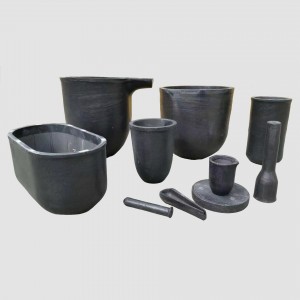
Crucible For Smelting play a crucial role in metal smelting, laboratory applications, and other high-temperature processes, and are highly praised for their high-temperature stability and thermal conductivity. However, over time, the surface of Metal Casting Crucible may be affected by wear and chemical corrosion, reducing their performance. In this article, we will delve into how to temper graphite crucibles to improve their performance and extend their service life.
What is Tempering?
Tempering is a heat treatment process commonly used to improve the hardness, strength, and corrosion resistance of materials. Although tempering is most commonly associated with metallic materials, it can also be applied to non-metallic materials such as Furnace Crucible in certain specific situations. Tempering involves heating the material to a relatively low temperature and then cooling it in a controlled manner to improve its properties while reducing its brittleness.
Why do we need to temper Melting Metal Crucible?
The main goal of tempered Smelting Crucibles is to improve their performance, including hardness, strength, and corrosion resistance. Crucibles For Melting Metal work under high temperature conditions and are susceptible to thermal stress and chemical corrosion. Therefore, by tempering, the stability and durability of the crucible can be enhanced, thereby extending its service life.
Specifically, tempered Industrial Crucibles have the following potential benefits:
1. Reduce brittleness:
At high temperatures, Melting Crucible may become fragile and prone to cracking. By tempering, the brittleness of the Melting Furnace Crucible can be reduced, making it more durable and reducing the risk of damage.
2. Increase strength:
Tempering can increase the overall strength of the crucible, enabling it to better withstand high temperatures and thermal stress. This helps to reduce deformation and damage to the Metal Melting Crucible.
3. Improve corrosion resistance:
Some chemical reactions may cause corrosion on the surface of Induction furnace crucible. By tempering, the corrosion resistance of the crucible can be improved, making it more resistant to chemical attack.
4. Improve performance consistency:
By tempering, the performance difference of the High temperature crucible can be reduced, making it more consistent, thereby improving the repeatability of experiments and production.
Steps for tempering graphite crucibles
The process of tempering graphite crucibles includes the following key steps:
1. Clean the crucible:
Before tempering, ensure that the surface of the crucible is clean and free from impurities or residues. Suitable cleaning agents can be used for cleaning and thoroughly rinsed with water.
2. Preheating:
Place the crucible in a hot furnace or heat treatment furnace and gradually raise the temperature to the desired tempering temperature. Usually, the tempering temperature is a specific requirement for graphite crucibles, which can be found in the specifications provided by the manufacturer.
3. Insulation:
Once the tempering temperature is reached, keep the crucible at this temperature for a period of time to ensure that the graphite structure changes. The insulation time usually varies depending on the size and material of the crucible.
4. Cooling:
Slowly cool the crucible to avoid thermal stress caused by sudden temperature changes. This can be achieved by reducing the furnace temperature or placing the crucible in insulating material after removal.
5. Inspection and Testing:
Once the crucible is cooled to room temperature, quality inspection and performance testing are carried out to ensure that the tempering process achieves the expected effect.
Precautions and suggestions
When tempering graphite crucibles, there are some important precautions and suggestions:
Follow the specifications and recommendations provided by the manufacturer to ensure the correct tempering process.
Use appropriate protective equipment, including heat-resistant gloves and goggles, to ensure safety.
Pay attention to the accuracy of tempering temperature and time to avoid excessive or insufficient tempering.
Regularly inspect the surface and performance of the crucible to ensure its continuous and stable performance.
In summary, tempered graphite crucible is a key heat treatment process that can improve the performance of the crucible and extend its service life. Tempering can make graphite crucibles more reliable in high-temperature applications by reducing brittleness, increasing strength, improving corrosion resistance, and improving performance consistency. Tempered graphite crucibles are a key step in ensuring high quality and repeatability in metal smelting, laboratory research, and other high-temperature processes.
Post time: Oct-13-2023
